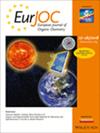阴离子识别诱导磷酸盐通过自组装分子胶囊从复杂的水基质中选择性分离
IF 2.7
3区 化学
Q2 CHEMISTRY, ORGANIC
引用次数: 0
摘要
选择性识别氧阴离子需要设计和合成能够区分大小、形状和碱度相当的阴离子的氢键供体(HBD)受体。尿素功能化的第二代三足阴离子受体已经被证明可以选择性地封装和分离磷酸盐离子(PO43 -和HPO42 -),从高阴离子和阳离子复杂性的水基质中。竞争液液萃取(LLE)实验显示,在过量竞争氧阴离子和卤化物存在的情况下,磷酸盐络合物的排他形成,这是从高度富营养化水生系统中有效回收磷酸盐的先决条件,也是作为有效磷酸盐粘合剂的治疗应用的重要条件。四丁基氢氧化铵作为受体增溶剂和阴离子交换剂,促进磷酸盐从水相转移到有机相(二氯甲烷)以交换氢氧化物离子。通过核磁共振(1H, 13C和31P)和质谱(HR - MS)证实了LLE衍生阴离子配合物的身份和纯度,建立了受体的磷酸选择性。单晶X射线衍射分析显示,磷酸盐包裹在受体的π堆叠二聚体胶囊组装中(2:1主客体复合物)。本文章由计算机程序翻译,如有差异,请以英文原文为准。


Anion Recognition‐Induced Selective Separation of Phosphates from Complex Aqueous Matrices by Self‐Assembled Molecular Capsule
Selective recognition of an oxoanion necessitates the design and synthesis of hydrogen bond donor receptors capable of discriminating between anions of comparable size, shape, and basicity. A urea‐functionalized second‐generation tripodal anion receptor has been demonstrated to selectively encapsulate and separate phosphate ions (PO43‐, and HPO42‐) from aqueous matrices of high anionic and cationic complexity. Competitive liquid–liquid extraction (LLE) experiments reveal exclusive formation of phosphate complexes in the presence of an excess of competing oxoanions and halide, which is a prerequisite for efficient phosphate recovery from highly eutrophic aquatic systems and also important for therapeutic applications as an effective phosphate binder. Tetrabutylammonium hydroxide has served as a receptor solubilizer and an anion‐exchange agent, facilitating phosphate transfer from the aqueous to the organic phase (dichloromethane) in exchange for hydroxide ions. The identity and purity of the LLE‐derived anion complexes are confirmed by nuclear magnetic resonance (1H, 13C, and 31P) and mass spectroscopy, establishing phosphate selectivity of the receptor. Single‐crystal X‐ray diffraction analysis reveals phosphate encapsulation within a π‐stacked dimeric capsular assembly of the receptor (2:1 host–guest complex).
求助全文
通过发布文献求助,成功后即可免费获取论文全文。
去求助
来源期刊
CiteScore
5.40
自引率
3.60%
发文量
752
审稿时长
1 months
期刊介绍:
The European Journal of Organic Chemistry (2019 ISI Impact Factor 2.889) publishes Full Papers, Communications, and Minireviews from the entire spectrum of synthetic organic, bioorganic and physical-organic chemistry. It is published on behalf of Chemistry Europe, an association of 16 European chemical societies.
The following journals have been merged to form two leading journals, the European Journal of Organic Chemistry and the European Journal of Inorganic Chemistry:
Liebigs Annalen
Bulletin des Sociétés Chimiques Belges
Bulletin de la Société Chimique de France
Gazzetta Chimica Italiana
Recueil des Travaux Chimiques des Pays-Bas
Anales de Química
Chimika Chronika
Revista Portuguesa de Química
ACH—Models in Chemistry
Polish Journal of Chemistry.

 求助内容:
求助内容: 应助结果提醒方式:
应助结果提醒方式:


